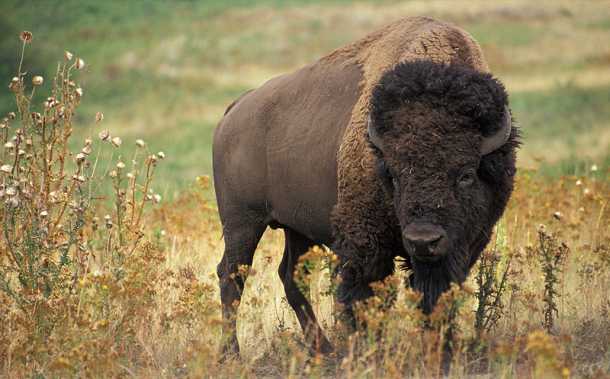
The "buffalo" burger - but is it really buffalo? (Photo Credit: Wikipedia)
Most report that Bison meat is a lean and delicious alternative to the more common beef burger. However, the availability of this meat confuses many casual diners. A common questions is, aren’t buffalo extinct because of hunting, and weren’t they the same thing as bison?
The short answer is no to all of that. The distinction can often be unclear though. So, what exactly IS the difference between bison and buffalo?
Classification
Classification of animals is a large and complex discipline called taxonomy. Taxonomists can categorize species of animals based on several factors like behaviour, physical structure and genetics. Since most people don’t have the time or inclination to become a taxonomic specialist, identifying animals outside of the zoo and Wikipedia is exceedingly difficult.
Generally, bison and buffalo are large, hairy organisms from the Bovine family, making them distant cousins to cows. There are several different distinct species that fall under the subheading of buffalo and less so for bison.
Buffalo

A domesticated water buffalo - one of the most common types of buffalo (Photo Credit: Wikipedia)
One common subset of buffalo is the water buffalo from Asia, which has both domesticated and wild species. Although the wild species are close to extinction, there are at least 130 million domesticated water buffalo, making it the most depended on domestic animal in the world. Water buffalo are a large, cow-like creature that is bred for milk and is classified based on behaviour and physical characteristics.
The African buffalo is different from the water buffalo in that the African buffalo is bigger and has never been tamed. These species are not closely related at all, but share several physical similarities. Buffalo species outside of the Western hemisphere have body types more similar to very large cows, with their necks extending straight from their spines, and their heads generally level with their shoulders. The issue within classifying buffalo species is that there has been a lot of interbreeding between different lines, which muddies the water.
Interestingly, the buffalo that Americans are most familiar with - the American buffalo, aren’t buffalo at all, but are American bison.
Bison

An American bison - commonly called the American buffalo (Photo credit: Wikipedia)
When people think of American buffalo, what they are thinking of is actually the American bison. Most of the confusion between buffalo and bison can be attributed to this common misnaming of the American bison.
Like buffalo, bison are closely related to cows. In fact, they’re so closely related that many private bison herds have large amounts of cow DNA present in the population. Unlike buffalo though, bison have distinctly different physical differences from cows that extend beyond size.
Bison are the ones with the pronounced furred hump at the shoulders. Their spine curves up over the shoulders and slopes down significantly towards the hind legs. The head of the bison sits much lower to the ground than where their spine peaks, giving them a permanently hunched look.
Heavy commercial hunting in the 19th century, along with disease introduced to the wild American bison population from domestic cattle has pushed the American bison to the brink of extinction. There are only around 15,000 wild bison left in North America - although there are around 500,000 raised in captivity.
Conclusions
As we have seen, there is a large difference between buffalo and bison in terms of their physiology. When you see actual photos of the two different organisms, its clear that they’re different species.
The confusion all comes from people incorrectly calling the American Bison a “buffalo”. There is even a species of European Bison that looks very similar to “American Buffalo”, which you would think would help clarify things, but only adds to the confusion.
The confusion remains terribly common - so common that American buffalo has become accepted as a colloquialism for American bison. When you look up the contents of the bison burger mentioned earlier, most websites do not know exactly what animal the meat comes from. Some say that it comes from buffalo and some say from the American bison, which, as we have seen, are completely different creatures.
However, now you’ll know what you’re looking at when someone shows you a bison and tells you it’s a buffalo.
Sources
“American Buffalo (Bison bison) species page U.S. Fish and Wildlife Service”. Retrieved on February 21, 2013.
Burnie D and Wilson DE (Eds.), Animal: The Definitive Visual Guide to the World’s Wildlife. DK Adult (2005), ISBN 0789477645
Cockrill, W. R. (1977). The water buffalo. Rome: Animal Production and Health Series No. 4. Food and Agriculture Organization of the United Nations.
Raphael, Marcel (2006). African Buffalo.